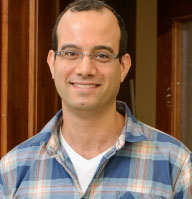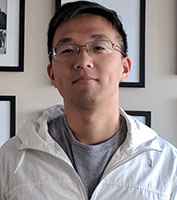Survol
[ English ]
Conférences en ligne du 1 octobre - 8 octobre 2021
Bo’az Klartag, Weizmann Institute of Science

Biographie: Le professeur Bo’az Klartag est un des leaders mondiaux en analyse géométrique. Il a obtenu son doctorat de l'Université de Tel Aviv en 2004 avant d'y être nommé professeur. Le professeur Klartag est bien connu pour ses contributions au domaine de l'analyse géométrique asymptotique, en particulier pour l'étude des phénomènes de grande dimension. En reconnaissance de ses contributions fondamentales, le professeur Klartag a été invité à présenter ses travaux à l'ICM 2006 à Madrid et il a reçu le prix de la Société mathématique Européenne en 2008 ainsi que le prix Erdös en 2010. Il est maintenant professeur au Weizmann Institute of Science.
Titre : Convexité et phénomènes de grande dimension
Vidéo de la conférence
En ligne le 1 octobre, 2021 à 11h00
Cette conférence s'adresse à un public mathématique général.
Abstract: High-dimensional problems with a geometric flavor appear in a number of branches of mathematics and mathematical physics. A priori, it seems that the immense diversity observed in high dimensions would make it impossible to formulate general, interesting theorems that apply to large classes of high-dimensional geometric objects. In this talk we will discuss situations in which high dimensionality, when viewed correctly, induces remarkable order and simplicity rather than complication. For example, Dvoretzky's theorem demonstrates that any high-dimensional convex body possesses nearly-Euclidean sections of large dimension. Another example is the central limit theorem for convex bodies, according to which any high-dimensional convex body has approximately-Gaussian marginals. There are strong motifs in high-dimensional geometry, such as the concentration of measure, which appear to compensate for the large number of different configurations. Convexity allows us to harness these motifs in order to formulate elegant and non-trivial theorems.
Titre : Isopérimétrie dans les corps convexes et la localisation stochastique d'Eldan
Vidéo de la conférence
En ligne le 5 octobre, 2021 à 11h00
Abstract: The Kannan-Lovasz-Simonovits (KLS) conjecture is concerned with the isoperimetric problem in high-dimensional convex bodies. The problem asks for the optimal way to partition a convex body into two parts of equal volume so as to minimize their interface. The conjecture suggests that up to a universal constant, the optimal solution is obtained by bisecting the convex body with a hyperplane. Some years ago it was proven that the KLS conjecture implies Bourgain's slicing conjecture. Recently, Chen has made significant progress towards the KLS conjecture, which utilizes the technique of Stochastic Localization by Eldan. In this lecture we will explain this method, and survey various results on isoperimetry and spectral gap under convexity assumptions.
Yuansi Chen, Duke University

Biographie: Étudiant de l'École Polytechnique de Paris, le Dr. Yuansi Chen a obtenu son doctorat en statistique à UC Berkeley en 2019. Après un stage postdoctoral en science des données à l'ETH Zürich, le Dr. Chen a rejoint le département de sciences statistiques à l'Université Duke l'année passée. Pendant son séjour à Zürich il a fait un énorme progrès dans une conjecture proposée par Kannan, Lovász et Simonovits il y a 25 ans. Il s'agit d'une percée majeure dont les implications vont de la statistique et l'informatique jusqu'à la géométrie en grande dimension, où la solution de la conjecture KLS donne aussi une réponse au problème des sections proposé par Bourgain.
Titre : Progrès récents sur la conjecture de Kannan-Lovasz-Simonovits (KLS) et le problème des sections de Bourgain I
Vidéo de la conférence
En ligne le 6 octobre, 2021 à 11h00
Abstract: Kannan, Lovász, and Simonovits (KLS) conjectured in 1995 that the Cheeger isoperimetric coefficient of any log-concave density or any convex body is achieved by half-spaces up to a universal constant factor. This conjecture now plays a central role in the field of convex geometry, unifying or implying older conjectures. In particular, it implies Bourgain's slicing conjecture (1986) and the thin-shell conjecture (2003). While it is natural to expect convex bodies to have good isoperimetry (in other words, not look like dumbbells), the progress on bringing down the Cheeger isoperimetric coefficient in the KLS conjecture has been stagnant in recent years. The previous best bound, with dimension dependency d^1/4, was established by Lee and Vempala in 2017 using Eldan's stochastic localization, and matches the best dimension dependency Klartag obtained in 2006 for Bourgain's slicing conjecture.
After becoming familiar with Eldan's stochastic localization technique in the previous lecture, first we aim to get familiar with the concept of "localization" and to view stochastic localization as an extension. Then we go through the Lee and Vempala (2017) proof to see in action a concrete application of stochastic localization.
Titre : Progrès récents sur la conjecture de Kannan-Lovasz-Simonovits (KLS) et le problème des sections de Bourgain II
Vidéo de la conférence
En ligne le 8 octobre, 2021 à 11h00
Cette conférence s'adresse à un public mathématique général.
Abstract: In recent work, Chen (2020) improved Eldan's stochastic localization proof technique, which was deployed in Lee and Vempala (2017), to prove an almost constant Cheeger isoperimetric coefficient in the KLS conjecture with dimension dependency d^o(1). Consequently, his proof also provides a substantial advance toward the resolution of Bourgain's slicing conjecture and the thin-shell conjecture.
After getting conformable with Eldan's stochastic localization technique, in this talk we navigate through how to refine the technique to provide the current best bound. We will complete the self-contained proof of Chen (2020) and highlight the new ideas involved. Finally, we will discuss some extensions and provide an outlook for future research directions.